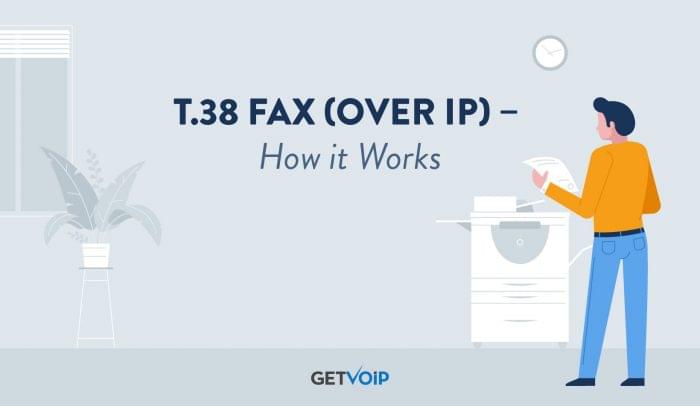Thanks to T.38, faxing is still a viable way to transmit various documents and forms. With an old school fax machine, data is sent over a phone line, translated into an image file, and then the signal is sent to the receiver on the endpoint that prints it out. Sending faxes looks a very different these days because it is now done over the internet using a VoIP phone number, instead of a landline connection through a machine.
T.38 is a protocol that enables fax over the internet — that means that a telephone network is rendered obsolete in this new process. In this article, we'll discuss the following sections:
- What is T.38 Fax?
- T.38 Fax Over IP Features
- T.38 vs G7.11
- The Benefits of Fax over IP
- T.38 Fax Modernizes an Old Technology
What is T.38 Fax?
This protocol is when a fax is sent over a computer data network. Faxes can’t be sent over IP networks in the same way voice communications can, so the protocol is done in a way that makes that possible. T.38 is typically used by a fax server instead of a machine.
T.38 utilizes voice over IP (VoIP) to send a fax. This process is known as virtual fax or FoIP — fax over IP. But while it does use the same process, it is important to note that these solutions are not completely identical to one another. Fax over IP requires an additional step to be complete.
VoIP allows users to make calls over an internet connection. This omits the need for expensive telephone service providers to make calls. Fax over IP sends faxes in the same way, meaning that this software saves its users money in the same way.

- Source: Tom’s Guide
Many businesses still rely on fax machines, but they can't read data the same way a computer with a modem can. The T.38 protocol was implemented to solve this business problem. This process defines how a device should communicate fax data so it can be sent over an IP network.
Fax over IP partitions data from a fax into an image that can be encoded and sent over the internet in real time. This is done with a fax gateway device that transitions data from the traditional phone signal to a format that can travel over IP.
A T.38-enabled device, also known as an internet-aware fax machine, is intended to preserve the complete accuracy of the image data from your fax. As it's being sent over the internet, a fax using T.38 can use additional bandwidth to ensure that everything on your document is correct. Accuracy checks are built into this fax protocol to ensure everything comes out the way it should.
Both allow communication traditionally done over phone lines to be completed over the internet. But where FoIP will use extra bandwidth to ensure accuracy and completion of your fax, VoIP telephony systems might present occasional glitches and jitters when the modem's connection is inconsistent. Although it's not ideal, it ensures your conversation is happening in real-time, similar to a traditional phone call.
This is the biggest difference between these tools. Fax over IP is used to send an accurate fax quickly. Information cannot be omitted from the document you are sending, since that would defeat the purpose of a fax. But as a VoIP call is meant to mimic a telephone call, momentary drops are considered to be acceptable.
T.38 Fax Over IP Features
Here's a list of features you can expect to find in a FoIP tool:
- Group Delivery – Group Delivery allows your businesses to send one fax to multiple different places simultaneously.
- Mobility – The ability to schedule, send and receive faxes from any device anywhere with an internet-connected modem.
- Electronic Signatures – This function allows senders and recipients to digitally sign and/or import handwritten signatures onto any document or form.
- Junk Fax Screening – Allows users to filter out spam faxes by utilizing either white or blacklisting functionality.
- Large File Sharing – Allows users to send documents over 100 pages long with ease, as well as videos, high-resolution images, audio files and spreadsheets.
- Scheduled Delivery – As the name states, this feature allows you to schedule an exact day and time for your fax to be sent.
- Progress and Status Tracker – This feature allows you to track your sent documents as they travel to the recipient so that you know exactly when they are received.
- Integrations and APIs – APIs are short, easy to use strings of web-based code that allow two platforms to interact with each other. APIs allow developers to construct bridges between two previously independent workforce solutions. (For example, enabling you to add a fax button directly into your CRM).
- Multiple Email Addresses – This feature enables you to link multiple email addresses to one fax line. This allows you to provide as many individual emails as you want with access to their own inbox and portal, all while still under one standalone online fax subscription.
- Fax Archive – This is a searchable, dedicated digital record of every fax transmission and received, account-wide.
What is the Difference Between T.38 and G.711?
T.38 is one of the two standard protocols for fax over IP. The other is G.711, which is the default for another fax over IP technique Pulse Code Modulation (PCM). It’s a method that turns analog signals into digital ones. G.711 is considered to be the simpler approach, as it's more connected to the original method of sending faxes.
Traditional faxes utilize a PSTN, and so does G.711. But this protocol converts those audio files into real-time transport protocol (RTP) packets, which is a process that enables those files to travel over an IP. That becomes the fax your recipient gets. G.711 is typically reserved for calls, which is how it works so well as an extension of the traditional fax.
But the fact that it is better suited for voice calls provides some challenges when it's used for sending faxes. G.711 hasn't been quite optimized for fax over IP in the same way that T.38 has. The biggest setback is that it doesn't typically support packet redundancy, which is a fax protocol's ability to check over data to ensure that nothing is missing. This is also known as packet loss.
T.38, however, can typically support two types of redundancy — control and data. Control redundancy refers to IP data packets containing fax control commands. This is considered to be low-speed redundancy. Data redundancy is the term for IP packets with fax image data and it is considered to be high-speed redundancy.
One way in which G.711 is superior to T.38 is that it is a significantly cheaper way to send faxes. The gateway support that T.38 uses for tax parameters isn't necessarily universal either. But it's the right protocol to go with if your business utilizes faxing a lot. If it's within your means, fax accuracy should come above these setbacks.
The Benefits of T.38 Fax
T.38 faxing over IP offers a number of benefits over alternative methods of sending faxes. For one, this protocol doesn't require much bandwidth to operate. That's because data is not transmitted over PSTN, as the traditional method of sending faxes does. As previously mentioned, that will save your business money. Additional bandwidth will only be used in the case that it's needed to ensure the accuracy of your fax data.
T.38 faxing is much simpler for your IT organization to operate, since it doesn't require as strong of a connection from your modem. With a FoIP system, your faxes are sent through just one server. Any device you send a fax from just serves as a point of origin.
Utilizing the T.38 protocol is also a more confidential way to send a fax. With the traditional method of sending faxes, you must physically bring your document to the machine. So there's a risk of unwanted eyes on your confidential documents. Fax over IP means you can send documents from your own device, ensuring everything remains private.
Conclusion: T.38 Faxing Modernizes an Old Technology
Fax machines may be a thing of the past, but sending faxes is not. Businesses have relied on faxes for decades for a good reason. It's a safe and reliable way to send important documents to your customers, especially documents and contracts that need a signature.
Fax over IP, is an essential VoIP feature of any telephony solution, and is the best way to continue this secure business practice. You can still send those documents with this practice, but you will save yourself time and money, and conduct your necessary business in a secure way. By deploying the T.38 protocol, you can do this in the most efficient way possible. If you're interested in making the switch, take a look at the best online fax services.




